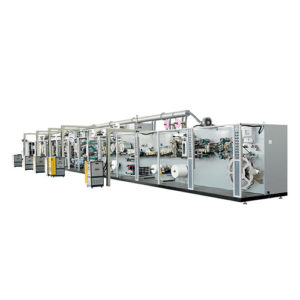The cutting and shaping of wings in winged sanitary napkins are critical steps in the manufacturing process. The wings provide additional side protection and help secure the sanitary napkin in place.
Here is an overview of how machines handle the cutting and shaping of wings in winged sanitary napkins:
1. Material Feed and Positioning:
- Material Unwind:
- Rolls of material, which can include the absorbent core, top sheet, back sheet, and wing material, are unwound from rolls.
- Alignment:
- The materials are aligned and positioned accurately using guiding systems to ensure precise cutting and shaping.
2. Cutting and Shaping Process:
- Die Cutting:
- Die-cutting machines are commonly used to cut the wings into the desired shape. A die is a specialized tool that cuts materials into specific shapes.
- Shape Design:
- The die is designed to cut the wings into the desired shape, sanitary napkin machine typically with a curve or contour that conforms to the anatomy of the wearer.
- Sealing:
- If necessary, the wings may be heat-sealed or bonded to the rest of the sanitary napkin during or after the cutting process.
- Scoring or Perforation:
- Machines may incorporate scoring or perforation features to create fold lines or tear-away portions, making it easier for the user to unfold and attach the wings when using the sanitary napkin.
3. Inspection and Quality Control:
- Vision Systems:
- Automated vision systems may be employed to inspect the cut wings for accuracy, shape, and defects.
- Any discrepancies or defects detected by the vision system trigger corrective actions.
- Reject Mechanism:
- Defective or misshaped wings are rejected from the production line through an automated system, ensuring that only quality products move forward.
4. Folding and Packaging:
- Folding:
- The sanitary napkin, including the wings, may go through a folding process to prepare it for packaging.
- Machines can fold the product efficiently, ensuring that wings are positioned correctly.
- Packaging:
- The folded sanitary napkins are then packaged using automated packaging machinery, which may involve individual or bulk packaging.
Additional Considerations:
- Adaptive Control Systems:
- Some modern machines incorporate adaptive control systems that can make real-time adjustments to the cutting and shaping process based on feedback from sensors and vision systems.
- Material Variations:
- The cutting and shaping process must be adaptable to different materials, as manufacturers may use various combinations of materials for the absorbent core, top sheet, back sheet, and wings.
- Scalability:
- Machines are designed to handle high-volume production efficiently, ensuring consistent and precise cutting and shaping of wings for large quantities of sanitary napkins.
By combining precision machinery, automation, and quality control measures, manufacturers can efficiently produce winged sanitary napkins with consistent and accurate wing shapes. Regular maintenance and calibration of the cutting equipment are essential to ensure the longevity and reliability of the production process.
